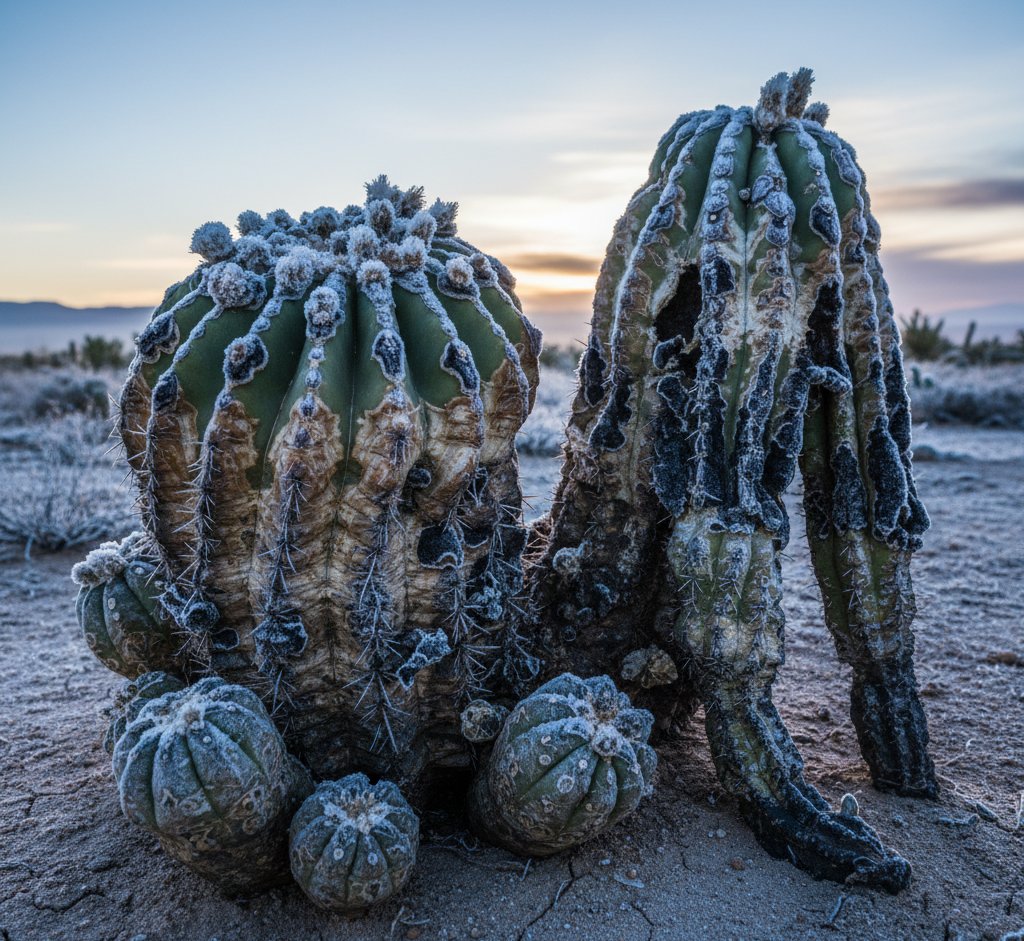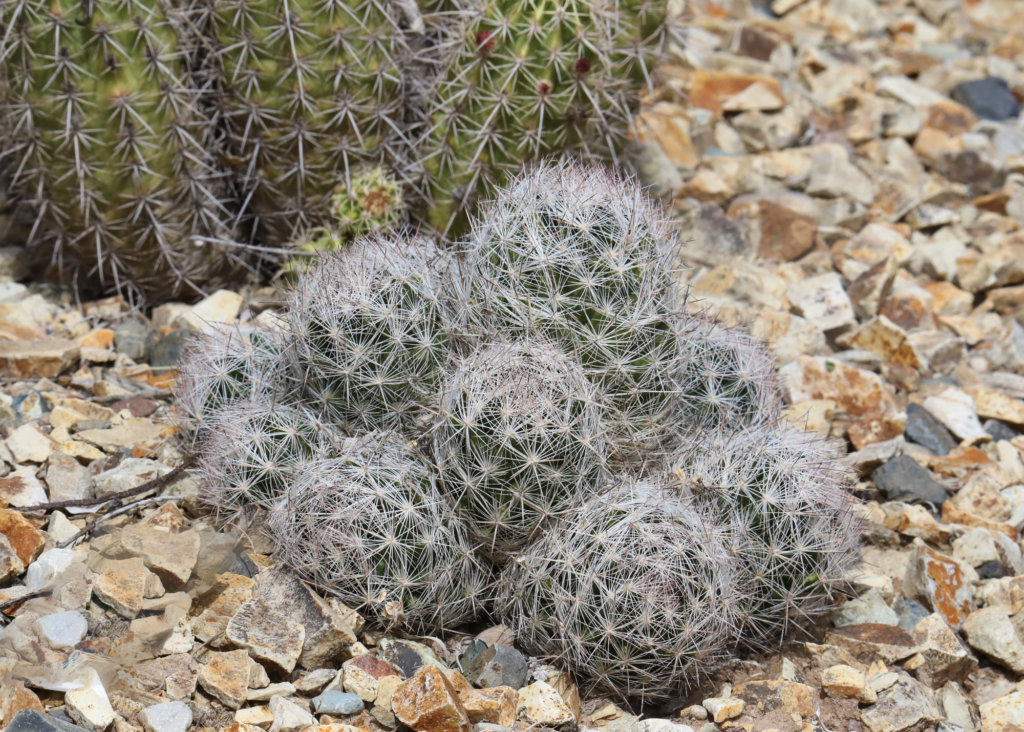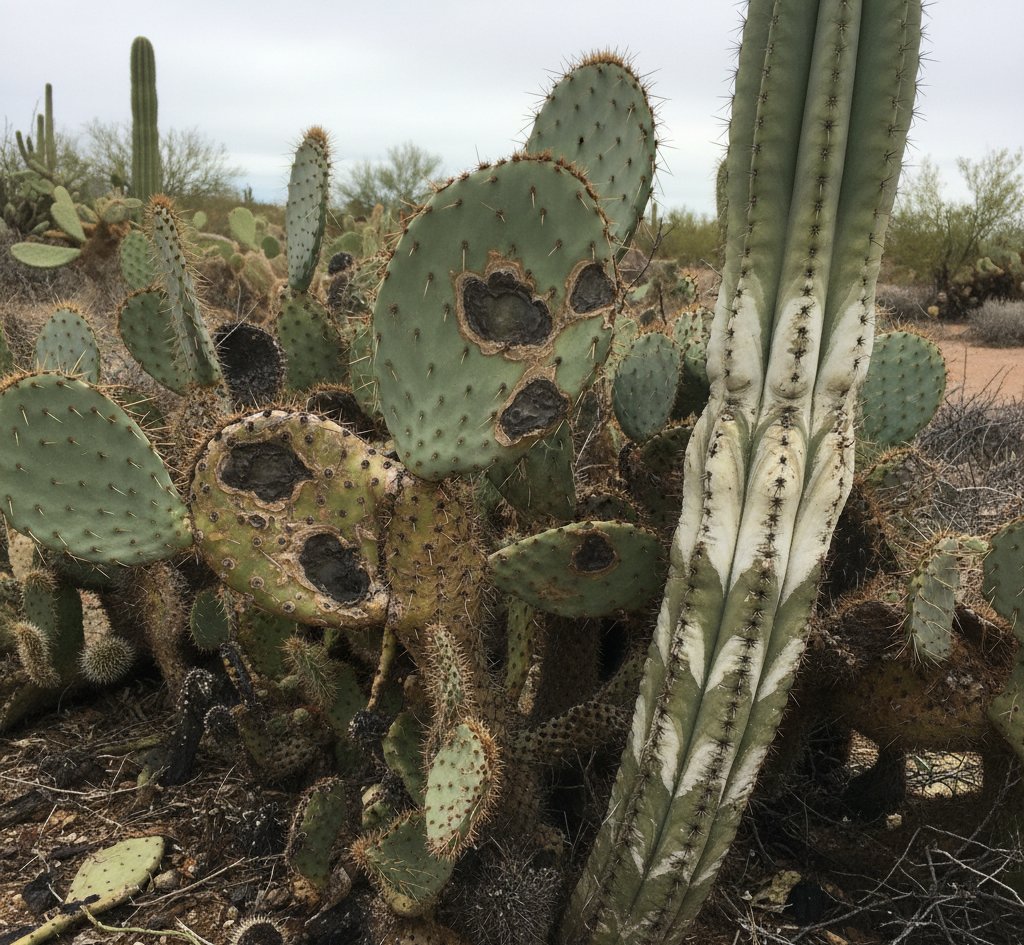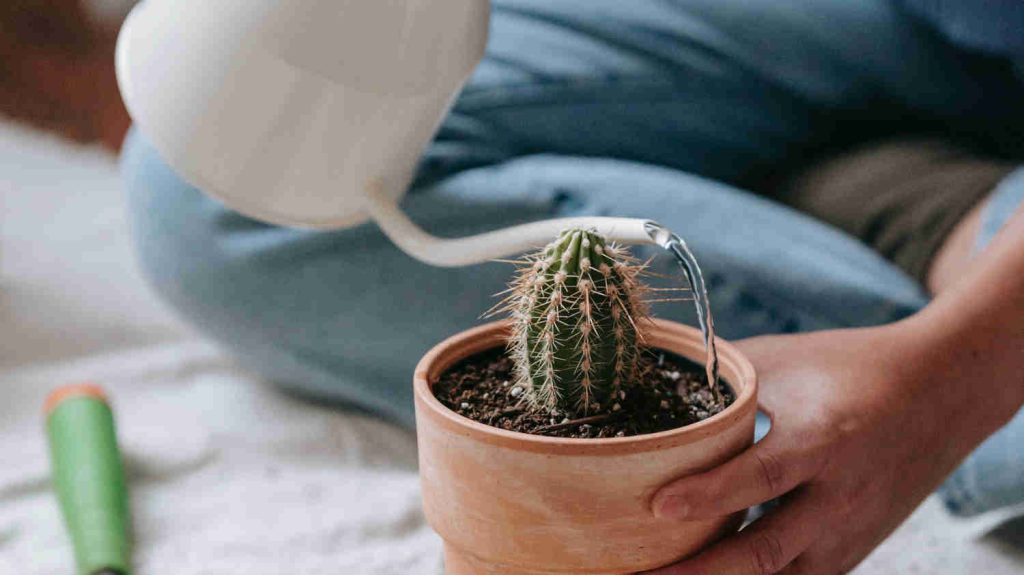How To Protect Cactus From Frost
Cold nights can cause serious damage to your cactus if you don’t prepare in time. Frost can freeze the plant’s tissues, leaving soft, dark spots that may never heal. To protect your cactus from frost, cover it with a breathable fabric like burlap or frost cloth, move it to a sheltered area, and reduce watering before temperatures drop.
You can keep your cactus healthy through winter with a few simple steps. Watch the weather forecast, bring potted cacti indoors when frost is expected, and make sure they still get bright, indirect light. For outdoor plants, create a barrier against cold winds using mulch or temporary covers that let air flow.
Key Takeaways
- Know how frost harms cacti and why protection matters
- Use simple methods like covers and shelter to prevent frost damage
- Support recovery and healthy growth after cold exposure
Understanding Frost Risks for Cacti
Cold weather can damage cacti by freezing their internal moisture and weakening their protective outer skin. Knowing which species tolerate cold and how to spot frost stress early helps you prevent lasting harm to your plants.
How Frost Damages Cacti

Cacti store water in their stems and pads, which makes them vulnerable to freezing. When temperatures drop below 32°F (0°C), the water inside their tissues can form ice crystals. These crystals puncture cell walls, causing soft spots, discoloration, and collapse.
Frost also affects the plant’s outer layer. A cactus’s waxy skin helps retain moisture, but extreme cold can crack or peel this surface. Once damaged, the plant loses protection against dehydration and infection.
Even short frosts can harm tender species such as Echinopsis (Hedgehog Cactus) or Golden Barrel. Repeated exposure intensifies damage because thawing and refreezing strain the tissues. In contrast, brief cold snaps may only scar the surface without killing the plant.
You can reduce risk by keeping soil dry before a freeze. Wet soil holds cold longer and increases the chance of root damage.
Cold-Hardy vs. Tender Cactus Varieties


Not all cacti react the same way to frost. Some species evolved in high-altitude or desert regions where nights are cold. Others come from warm climates and cannot handle freezing temperatures.
| Type | Example Species | Typical Cold Tolerance |
|---|---|---|
| Cold-hardy | Opuntia humifusa (Eastern prickly pear), Escobaria vivipara (Beehive Cactus) | Down to -20°F (-29°C) |
| Tender | Echinocactus grusonii (Golden Barrel), Mammillaria elongata (Lady Finger Cactus) | Above 40°F (4°C) |


Cold-hardy cacti often have smaller, thicker pads and less water content. This adaptation limits ice formation inside their tissues. Tender and tropical cacti, however, rely on steady warmth and dry air.
Knowing your plant’s tolerance helps you plan protection. You can group tender species in sheltered areas or bring potted ones indoors when frost warnings appear.
Recognizing Signs of Frost Stress

The full extent of frost stress may take days or weeks to appear. Early symptoms include dark, mushy patches, pale or translucent skin, and softened stems. These areas may later dry out and turn brown or black.
In prickly pears, pads may sag or wrinkle as internal water cells burst. Columnar cacti might show sunken lines or sections that collapse inward. The damage often starts on the side facing the coldest wind.
If the plant’s core remains firm, it may recover once temperatures rise. Remove rotted tissue with a clean knife to prevent rot from spreading. Avoid watering until the plant shows signs of new growth, as excess moisture can worsen decay.
Essential Frost Protection Methods
Cacti vary widely in cold tolerance; while some are naturally cold-hardy, others are easily damaged by even brief frost, with extended freezing being lethal for many. You can reduce this risk by shielding plants with breathable covers, insulating the soil, creating controlled environments, and moving vulnerable pots indoors before freezing nights.
Using Frost Cloth and Covers

A frost cloth provides a simple and effective way to protect cacti from freezing air. This lightweight fabric traps ground heat while allowing air and light to pass through. Avoid using plastic sheeting, which can trap moisture and cause rot.
Drape the cloth loosely over the cactus before sunset and secure it with stakes or rocks. Remove it in the morning when temperatures rise above freezing.
If you don’t have frost cloth, use burlap, old sheets, or breathable garden fabric. These materials prevent frost from settling on the surface while letting humidity escape.
| Material | Breathability | Ideal Use |
|---|---|---|
| Frost cloth | High | Nighttime frost protection |
| Burlap | Medium | Wind and frost barrier |
| Plastic | Low | Not recommended due to condensation |
Mulching and Insulating the Root Zone

Cold air and frost often damage the roots before the visible parts of the cactus. Adding mulch around the base helps trap soil warmth and reduce temperature swings.
Use dry materials like straw, bark chips, or gravel mulch. Spread a layer about 2–3 inches thick, keeping it slightly away from the stem to prevent moisture buildup.
For ground-planted cacti, you can also add rocks or pavers around the base to store daytime heat and release it at night. This method works well in areas with short frost periods.
Check the mulch after heavy rain to ensure it stays dry. Wet mulch can lead to rot, especially in cold conditions.
Creating a Mini Greenhouse

A mini greenhouse offers steady protection for multiple cactuses during cold months. It traps heat from sunlight during the day and slows heat loss at night.
You can use a small plastic or polycarbonate frame with vents for airflow. Keep the interior dry by opening vents on warm days to prevent humidity buildup.
Inside the structure, place potted cacti on shelves or raised surfaces to avoid ground chill. For added warmth, line the base with gravel or thermal mass materials like bricks.
In regions with frequent frost, a mini greenhouse can extend the growing season and reduce the need for nightly covering.
Relocating Potted Cacti Indoors

To protect potted cacti, move them indoors before temperatures consistently drop below 50°F (10°C). Choose a bright, cool room with good air circulation. Avoid placing them near heating vents or drafty windows.
Before moving them, check that the soil is dry. Wet soil during a period of reduced light and dormancy significantly increases the risk of root rot.
If sunlight is limited, use a grow light for several hours each day to maintain healthy growth. Keep the plants spaced apart to allow airflow and reduce the risk of fungal issues.
When outdoor nighttime temperatures are reliably above 50°F (10°C), gradually reintroduce your cacti to outdoor light to prevent sunburn.
Winter Care Tips for Healthy Cacti
Cold weather affects how you water, light, and position your cacti. Managing moisture, temperature, and exposure helps prevent frost damage and keeps your plants stable through winter.
Adjusting Watering Routines

Cacti need much less water in cold months because growth slows down. Overwatering during this time often causes root rot, especially when soil stays cold and wet.
Water only when the soil is completely dry. For indoor plants, this typically translates to an extended period between waterings, perhaps 3–4 weeks or more, depending on your home’s conditions. Use a well-draining soil mix and pots with drainage holes to prevent standing water.
Avoid watering before a freeze. Saturated soil will freeze, and the expanding ice crystals can fatally damage the roots and plant tissues. If your cactus grows outdoors, water early in the day so excess moisture evaporates before temperatures drop at night.
Optimizing Light and Temperature

Cacti still need sunlight in winter, even though they rest. Place them near your brightest window (often south-facing) for 3–6 hours of bright light daily to prevent stretching. If natural light is limited, use a grow light to maintain healthy color and shape.
Indoor temperatures between 50°F and 65°F (10–18°C) suit most species. Avoid placing cacti near heaters or vents that cause sudden temperature changes. Stable conditions prevent stress and dehydration.
If your area experiences long, dark winters, rotate your pots every few weeks. This helps your cacti grow evenly and prevents them from leaning toward the light source.
Keep airflow moderate. Good ventilation reduces humidity and lowers the risk of fungal growth or rot.
Positioning for Shelter and Wind Protection
Even cold-hardy cacti benefit from protection against frost and wind. If your plants grow outdoors, move them under a covered patio, porch, or eave before freezing weather hits. This limits exposure to frost while still allowing light.
For ground-grown cacti, cover them with frost cloth or breathable row covers on cold nights. Avoid plastic, which traps moisture and can cause damage when it freezes.
Indoors, keep cacti away from drafty windows or doors. Cold air leaks can chill the soil and roots. If using a greenhouse or sunroom, maintain the minimum temperature appropriate for your specific cactus species’ winter dormancy requirements.
Windbreaks, such as fences or shrubs, also help protect outdoor cacti by reducing wind chill and moisture loss.
Restoring Cacti After Frost Exposure
Cacti can survive brief frost, but extended cold can damage their tissues. You can restore frost-affected plants by removing damaged parts, improving conditions, and supporting new growth through careful watering and warmth.
Assessing and Treating Frost Damage

Start by checking your cactus for discoloration, mushy spots, or blackened areas. These signs show that ice crystals have damaged the plant’s cells. Prickly pear and other species with flat pads often show soft or translucent patches first.
Use clean, sharp pruning shears to remove dead or mushy tissue. Cut slightly into healthy, firm tissue to stop rot from spreading. Disinfect tools between cuts to prevent infection.
Keep the plant dry for several days after trimming. Avoid watering until the cut surfaces form a callus. This step helps prevent bacteria and fungi from entering the wounds. If the cactus sits outdoors, move it to a dry, shaded area with temperatures above 40°F (4°C).
If frost damage affects the roots, gently unpot the cactus and inspect them. Trim any black or soft roots and repot in fresh, well-draining soil. Avoid fertilizing until the plant shows signs of recovery.
Encouraging Recovery and Regrowth
Once the cactus stabilizes, gradually reintroduce sunlight. Begin with indirect light for a few days, then increase exposure as the plant strengthens. Too much direct sun too soon can stress weakened tissues.
Water sparingly. Wait until the soil is completely dry before watering again. Overwatering slows healing and may cause rot.
Maintain a steady temperature between 60–75°F (15–24°C) to promote new growth. You can use a heat mat for small cactuses or prickly pears recovering indoors.
When new growth appears, resume light feeding with a diluted cactus fertilizer. This supports regrowth without overwhelming the plant. Keep monitoring for any new soft spots or discoloration, and remove them early to protect the healthy tissue.

